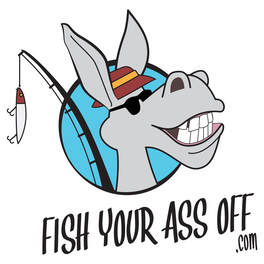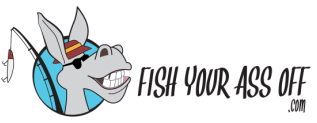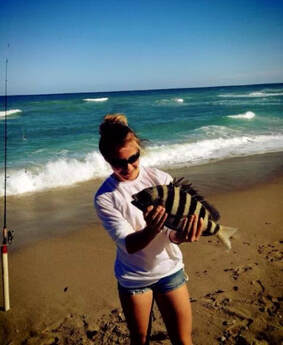
What is the best tide for sheepshead fishing?
The best tide for sheepshead fishing is high tide. Sheepshead like to forage around the bridge pilings, docks, sea walls and inlets for food. The higher water levels give the sheepshead complete access to the barnacles, oysters, crabs, shrimp and small fish that live on the underwater structures.
The outgoing tide is a great tide to fish for just about any species of fish, not just for sheepshead. The outgoing tide is more dirty than the incoming tides from the Atlantic Ocean and Gulf of Mexico. This helps you hide your hooks and lines from those sharp eyes of the sheepshead.
You really need to use light mono filament line or fluorocarbon leaders when you are targeting sheepshead. These sharp eyed fish are excellent bait stealers so you will want to hide your hook the best that you can too.
Sheepshead will feed on any tide as long as it is moving but they are more apt to ignore your baits when the water is clear and they can see your line or hook.
The author of this article is a FISHING CHARTER CAPTAIN. He has been fishing the grass flats, oyster bars and mangroves for sheepshead all over Florida for more than 40 years.
In the article below, we will talk about the the best tides for sheepshead fishing and the best baits, lures and techniques.
Let's get started.
The sheepshead below was caught during the high tide off of the beach.
The best tide for sheepshead fishing is high tide. Sheepshead like to forage around the bridge pilings, docks, sea walls and inlets for food. The higher water levels give the sheepshead complete access to the barnacles, oysters, crabs, shrimp and small fish that live on the underwater structures.
The outgoing tide is a great tide to fish for just about any species of fish, not just for sheepshead. The outgoing tide is more dirty than the incoming tides from the Atlantic Ocean and Gulf of Mexico. This helps you hide your hooks and lines from those sharp eyes of the sheepshead.
You really need to use light mono filament line or fluorocarbon leaders when you are targeting sheepshead. These sharp eyed fish are excellent bait stealers so you will want to hide your hook the best that you can too.
Sheepshead will feed on any tide as long as it is moving but they are more apt to ignore your baits when the water is clear and they can see your line or hook.
The author of this article is a FISHING CHARTER CAPTAIN. He has been fishing the grass flats, oyster bars and mangroves for sheepshead all over Florida for more than 40 years.
In the article below, we will talk about the the best tides for sheepshead fishing and the best baits, lures and techniques.
Let's get started.
The sheepshead below was caught during the high tide off of the beach.
What tide is best for sheepshead fishing the inlets?
The top of the outgoing tide is the best tide for sheepshead fishing in the inlets. The reason this tide works so well for catching sheepshead is because the water on the outgoing tides in the inlets is usually dirty because of freshwater drainage and sediment from inshore.
This makes it easier to fool the sheepshead with your bait and lure offerings. There are some lures that will catch sheepshead believe it or not. There are small fake crab lures specifically designed to target these fish. Many anglers use these new lures to target these fish. I have caught sheepshead on 3 inch paddle tail jigs and small spoons before but natural bait works the best.
The sheepshead in the inlets will be foraging along the rocks and sea walls of the inlets picking at the barnacles and oysters that are attached to those structures. What you have to do to catch them is get your crab or shrimp offering in front of those sheepshead.
A #2 hook; a split shot or small egg sinker and a small piece of shrimp or a fiddler crab or mangrove crab will not be ignored by any hungry fish in the area.
What tide is best for sheepshead fishing bridges?
The top of the outgoing tide is that best tide for sheepshead fishing the bridges too. It can be the top of the incoming tide too but the higher parts of the tide give the sheepshead access to all of the oyster and barnacles growing on the pilings of the bridges.
The sheepshead are often still there during the lower parts of the tide but it seems to me that there are always more around when the water volumes are at their highest levels.
The winter months are the best ones for catching sheepshead inshore but they are here year round. I wrote another article on this website that covers in great detail how to target sheepshead in the winter. You can see that article by clicking right here.
Once again the key to getting a bite is to get your bait or lure offering down to where the fish are. You might need more weight to get it to the fish when the tide is strong but it will be much harder to feel the bite of the bait stealing experts.
What tide is best for sheepshead fishing oyster bars, docks, mangroves, the beach and grass flats?
Oyster Bars
Sheepshead love to root around the oyster clumps looking for small fish, crabs and shrimp to eat. They will often tail just like the redfish are known for. I have pitched my shrimp and split shot offering to many "tailing redfish" only to end up with a big sheepshead on the end of my line instead.
I like to fish around the oyster bars during the lower parts of the tide for sheepshead because it is so much easier to sight fish for them when the water volumes are low. These fish will hang out in some surprisingly shallow water as they search for food around oyster bars.
You will want to scan the edges of the spartina grass lines if you are fishing during the higher parts of the tide for tailing sheepshead. They will probably be working their way into the grass with the high water but you can still sight fish them sometimes.
WANT TO CATCH SHEEPSHEAD? BOOK YOUR FISHING CHARTER TODAY!
Docks
Docks are another great place to target sheepshead during the higher parts of the tide. The older docks definitely seem to hold more fish than the newer docks. This is because the newer docks have not had enough time to grow mussels, barnacles, oysters, sponges, marine plants and anything else that will attract crabs, shrimp and fish to them.
With a stealthy approach you will see the sheepshead poking around the pilings in search of a bite to eat. These fish will stay around during the lower parts of the tide too but there will be fewer to target.
Quite often they will be very close to the shoreline but you have to be extremely stealthy to get a good cast to them. They spook very easily in the super skinny water.
When the tide is towards the lower end, then you will want to fish the deeper parts of the docks around the pilings or any pot holes that are near the docks. I like to target docks that have large boats tied to them.
The reason that I like docks with big boats is because they need deeper water to launch. This means that there will be a deeper channel near those docks. Sheepshead like those deep channels to wait out the lower parts of the tide.
Mangroves
The roots of the red mangrove tree are an amazing place to target sheepshead during the higher parts of the tide. Snook, redfish, mangrove snappers, flounder and of course sheepshead use those roots to find shrimp, crabs, barnacles, oysters and small fish to eat. It is also a safe place to hide from dolphins and sharks that would love to eat them.
When the water is clear you can cruise the the lines of mangrove trees as far away as you can cast and sight fish for sheepshead. They key is to keep the roots just within casting range so that you don't spook the fish with your presence.
You need to have your shrimp or crab with a weight ready to pitch to the mangrove roots once you see the sheepshead and wait. They will smell your bait even if they don't see it at first so be patient and wait for them to pick it up.
Maximize your winter sheepshead bite by watching this video.
The Beach
The beach is another great place to target sheepshead during the higher parts of the tide. This photo is of one of my daughters that was very happy to catch her first sheepshead using frozen shrimp with a one ounce egg sinker knocker rig.
There was a break in the reef where we were fishing this day and the croakers, sheepshead and whiting were all over our frozen shrimp offerings in spite of the wind and waves.
PRO TIP- You have to find a beach with some sort of structure. It can be a few rocks or a whole reef but you will need to fish structure to catch a ton of sheepshead off of the beach. A beach that is all sand is great for pompano, permit, whiting and croakers but not for sheepshead.
Grass Flats
Sheepshead will hit the grass flats in search of shrimp and crabs when they are abundant during the higher parts of the tide. Again you will have to be stealthy and see them before they see you if you want to sight cast to them.
They are often in the sandy pot holes that are on every grass flat that I have ever seen. A great way to fish the grass flats is to let the tide or the wind move you across them quietly. You just have to be ready to present your shrimp or crab offering to the sheepshead that you encounter without spooking them.
The smallest weight that you can use to get it to them is your best bet. I like to use split shots that are just big enough to cast far enough and sink deep enough to get in the sheepshead strike zone.
Conclusion:
Sheepshead are one of those fish that many anglers ignore. BUT you shouldn't because they are great fighters and they are good to eat if you are a meat fisherman. They are one of the best bait stealers that exists so you will need to downsize your hooks, leaders and baits to maximize your catch.
I am not a big fan of fluorocarbon line but when the water is super clear it really can make a big difference with sharp eyed fish like sheepshead. An 8 pound leader will do the trick and the fluorocarbon line is very abrasion resistant.
I owe a lot to the sheepshead. Sheepshead gave me my start in saltwater fishing when I was just 5 or 6 years old. My father and older brothers would take me to a mangrove island to catch fiddler crabs. We were armed with 10 foot cane poles; 8 pound mono filament line; split shots and #2 hooks.
We would fish the high tide and catch 20 or 30 sheepshead some days. Those fishing adventures are what got me hooked on inshore fishing and I never stopped.
Do you like how to fishing articles like this one? If you answered yes, then sign up for our email list and we will send you how to fishing articles and videos every week. Sign up now and get your first one today.

